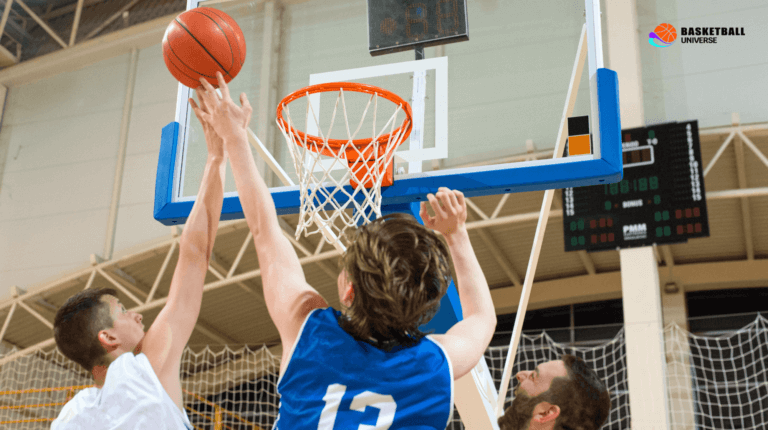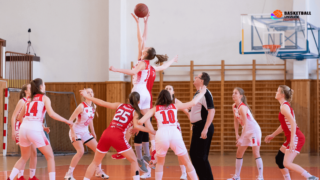
High school basketball games are often filled with excitement, fierce competition, and memorable moments that create a thrilling atmosphere for players, coaches, and fans alike. If you’re curious about the duration of these action-packed showdowns on the court, you’ve landed in the right place! In this blog post, we’ll delve into the nuances of high school basketball game lengths, taking into account factors such as playing time, breaks, and possible overtime scenarios. So, lace up those sneakers and get ready to learn some fun and insightful facts about high school basketball game durations!
How Long Is High School Basketball Game?
A typical high school basketball game lasts around 1 to 1.5 hours, with four 8-minute quarters making up the 32-minute playing time. Factoring in timeouts, halftime, and potential overtime periods, the total duration can vary.
Understanding the Components of a High School Basketball Game
Before we dive into the specific details that determine the length of a high school basketball game, it’s essential to understand the components and structure of the game itself. This will provide a solid foundation for the rest of the discussion, and help you comprehend how various factors shape the game’s overall duration.
Quarters and Quarter Length
In high school basketball, the game is divided into four quarters, each lasting 8 minutes. This amounts to a total playing time of 32 minutes, which is notably shorter compared to college (40 minutes) and NBA games (48 minutes). The shorter game length is chosen to maintain a faster pace and prevent players from becoming overwhelmed, as they are typically still developing their skills and stamina.
Halftime Breaks
Between the second and third quarters, there is a halftime break, allowing players to rest, recover, and receive instructions from their coaches. Most high school games have a 10-minute halftime break, although the exact duration may vary depending on the specific league or conference.
Timeouts
Another factor that contributes to a high school basketball game’s time is the number of timeouts that can be taken by each team. Generally, teams are given five timeouts per game, with three 60-second full timeouts and two 30-second short timeouts. Keep in mind that timeouts may not be used consecutively, and the total number may differ depending on the specific rules of the region or league.
The Role of Overtime in High School Basketball Game Duration
Regulation Time and Overtime Scenarios
Upon the completion of the fourth quarter, if the game is tied, an overtime period will be required to determine the winner. In high school basketball, each overtime period lasts 4 minutes. If the score remains tied after an overtime period, additional overtime periods will continue to be played until a winner emerges.
Overtime Impact on Game Duration
While the overall impact of overtime periods on the game’s length may seem insignificant, it’s essential to remember that each additional overtime period adds not only the 4-minute gameplay but also the 1-minute break between overtime periods. Consequently, a single overtime period may extend the game’s duration by at least 5 minutes, with even longer games occurring in multiple overtime periods.
Factors that Affect the Flow of the Game
Fouls and Free Throws
Fouls are an integral part of any high school basketball game, and they can significantly impact the game’s flow and duration. When a player commits a personal foul or a technical foul, the opposing team may have the opportunity to shoot free throws. During free throws, the game clock is stopped, leading to a longer game duration. Additionally, the time taken for referees to communicate the foul, the fouled player preparing for the free throw, and the act of shooting the free throw can cause a few extra minutes to accumulate over the course of the game.
Substitutions
Substitutions are a critical strategic tool for high school basketball coaches, who may use them to maintain their players’ energy levels, address specific matchups, or manage foul trouble. While substitutions can occur relatively quickly, occasionally they may also be a deciding factor in extending the game’s duration. When a player is substituted into the game, there may be a brief pause in gameplay as referees confirm the change, the departing player exits the court, and the incoming player moves into position.
Ball out of Bounds
High school players, just like their professional counterparts, are not immune to the occasional error or misdirected pass, causing the ball to go out of bounds. When this happens, the game is temporarily halted as players reset their positions, and the team that didn’t touch the ball before it went out of bounds regains possession. While each instance of the ball going out of bounds may only last a few seconds, these stoppages can accumulate over the course of a game, contributing to an extended duration.
Factors that Vary by Region or Tournament
Conference or League Rules
While high school basketball follows a generally consistent set of rules nationally, it is important to remember that individual conferences or leagues may adopt specific variations that can impact the game’s duration. Examples of such variations might include quarter length, allowed number of timeouts, or the length of the halftime break. Always consult the rules of the specific conference or league for the most accurate information.
Tournament Scenarios
In some cases, high school basketball games take place as part of larger tournaments, where games are played in a condensed format to accommodate multiple contests in a single day. In these scenarios, game durations may be reduced, with shorter quarters, fewer timeouts, or abbreviated overtime periods. Additionally, halftime may be shortened to ensure that games stay on schedule. Confirming the specific tournament rules is essential to understanding the duration of these games accurately.
Timekeeping and High School Basketball Games
Clock Management and Official Timekeepers
High school basketball games often require careful clock management to ensure accurate timekeeping and adherence to the rules. Official timekeepers, typically an adult volunteer or school staff member, are responsible for starting and stopping the game clock as required by the game’s rules. They must monitor the clock and ensure that fouls, timeouts, and other stoppages are accurately recorded to provide an authentic game experience for players, coaches, and fans.
Implications of Game Duration on Player Performance and Spectator Experience
On-court Performance, Stamina, and Recovery
Players’ performance may be influenced by factors such as fatigue, strategy and the ability to maintain a high level of intensity throughout the game. Understanding the game’s duration helps players, coaches, and trainers plan accordingly to optimize their on-court efforts. Emphasis on physical conditioning, recovery methods, and strategic substitutions enables athletes to manage their stamina and maximize their performance during the game.
Enjoying the Game as a Spectator
For spectators, appreciating the overall experience of a high school basketball game goes beyond the final score. The energy, camaraderie and excitement of cheering for your favorite team can make time fly. Knowing the average length of a high school basketball game helps spectators plan their schedules, ensuring they can enjoy the game without stress or unnecessary interruptions. So grab a seat, make some noise, and revel in the world of high school basketball!
Conclusion
High school basketball games offer an exceptional mixture of athleticism, strategy, and excitement, which is why understanding their average length is so essential for players, coaches, and fans alike. With diverse factors influencing the game’s duration, such as quarters, halftime breaks, and overtime scenarios, being prepared and informed allows you to appreciate and engage in the dynamic environment that unfolds on the basketball court. Enjoy the game and have fun!
Preparing for a High School Basketball Game
Knowing the length of a high school basketball game is essential for not only the players and coaches but also for spectators and parents who might want to prepare for the event accordingly. In this section, we will discuss tips and considerations to help you get ready for game day and ensure a memorable basketball experience for all involved.
Arrival and Warm-up Time
Arriving early to a high school basketball game is crucial for both players and spectators. Players should allocate enough time for a proper warm-up routine, which includes stretching, jogging, and shooting drills. This can help prevent injuries, improve performance, and mentally prepare athletes for the game. For spectators, early arrival guarantees comfortable seating and ensures they don’t miss any exciting moments of the game.
Snacks and Hydration
As high school basketball games can last around 1 to 1.5 hours, it’s crucial to bring enough water and healthy snacks, such as granola bars, fruit, or popcorn, that can be consumed before or after the game, or even during halftime. Hydration is essential to maintain energy, focus, and overall well-being for players, while spectators can enjoy the event without feeling hungry or thirsty.
Fan Gear and Support
Supporting your favorite high school basketball team is part of the fun! So, make sure to wear your team’s gear, such as a shirt, hat, or scarf, to represent your team spirit. Don’t hesitate to bring a small handheld sign or other sorts of props to show your enthusiasm and make the game even more exciting for the players and fellow supporters.
Additional Basketball Game Insights and Fun Facts
Now that you have a comprehensive understanding of high school basketball game durations and how to prepare for them, let’s explore some interesting basketball facts that will not only enhance your knowledge but also serve as a great conversation starter at the next game!
Shot Clock Rules
In many states, a shot clock is used in high school basketball games to control the game pace and encourage teams to take more shots within a limited time. Generally, the shot clock can vary from 30 to 35 seconds. It resets each time a successful shot is made or the opposing team gains possession of the ball.
Historical Differences in Game Length
The quarter system in high school basketball games wasn’t always the standard. Many schools used to play 20-minute halves instead of four 8-minute quarters. The switch to quarters was implemented to provide more breaks and a better structure, aligning high school basketball with professional leagues’ format.
The Evolution of Overtime Rules
Overtime rules in basketball have evolved over the years as well. Initially, there was no overtime, and games that ended in a tie remained a tie. Eventually, a “sudden death” overtime system was introduced, where the first team to score would win the game. However, this system was deemed unfair and was replaced with today’s standard 4-minute overtime rule.
High School Basketball Stars
Many talented NBA players made their mark on high school basketball courts before turning pro. LeBron James, Kobe Bryant, and Kevin Durant are just a few examples of players who began building their legacy early on. High school basketball games can be a chance to witness potential future stars showcasing their skills and passion for the sport.
Frequently Asked Questions
In this FAQ section, we aim to address some common questions that are semantically related to our main topic, “How Long Is High School Basketball Game?”. These questions and their concise NLP-style answers will enhance your understanding and help clarify any potential confusion around the subject.
1. Why are high school basketball games shorter than college or professional games?
High school basketball games are shorter because the players are still developing their skills and stamina. Reducing the game’s length helps maintain a faster pace and prevents the players from becoming overwhelmed.
2. What happens if a high school basketball game ends in a tie?
If a game ends in a tie, one or more 4-minute overtime periods will be played until a winner is determined. There is a 1-minute break between overtime periods.
3. How many quarters are there in a high school basketball game?
A high school basketball game consists of four quarters, each lasting 8 minutes.
4. How long is the halftime break in a high school basketball game?
The halftime break in most high school basketball games is 10 minutes, although this may vary depending on the specific league or conference.
5. How many timeouts can be taken in a high school basketball game?
Typically, teams get five timeouts per game, consisting of three 60-second full timeouts and two 30-second short timeouts. This number may differ based on specific league or conference rules.
6. Is there a shot clock in high school basketball games?
In many states, high school basketball games use a shot clock to control the game pace. The shot clock typically varies from 30 to 35 seconds.
7. Can high school basketball games have different rules depending on region or tournament?
Yes, specific rules may vary between regions or leagues, which might impact game duration. This can include quarter length, timeouts allowed, and halftime break duration. Tournament scenarios may also have modified rules for game length.
8. How long does an overtime period last in high school basketball?
An overtime period in high school basketball lasts 4 minutes, with a 1-minute break in between periods if additional overtime is required.
9. How does the game flow affect a high school basketball game’s length?
Factors like fouls, free throws, substitutions, and instances of the ball going out of bounds can cause brief pauses in gameplay and extend the game’s duration.
10. What should I bring to a high school basketball game as a spectator?
Bring plenty of water, healthy snacks, and fan gear to enjoy the game comfortably and display your team spirit.
11. How early should players and spectators arrive for a high school basketball game?
Players should arrive early enough to complete a proper warm-up routine. For spectators, early arrival ensures comfortable seating and prevents missing any exciting game moments.
12. Can high school basketball games have reduced lengths during tournaments?
Yes, tournament games might have shorter quarter lengths, fewer timeouts, or abbreviated overtime periods to accommodate multiple games in a single day.
13. What is the role of an official timekeeper in high school basketball games?
The official timekeeper is responsible for managing the game clock and ensuring that timeouts, fouls, and other stoppages are accurately recorded, providing a seamless game experience for players, coaches, and fans.
Featured Posts
- No pillar pages found.





